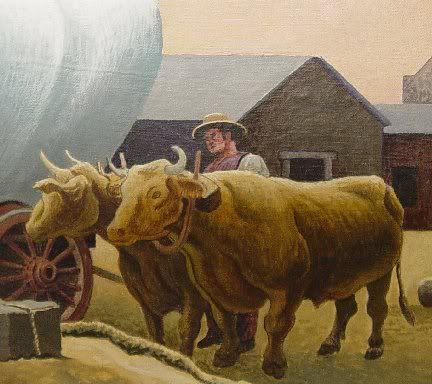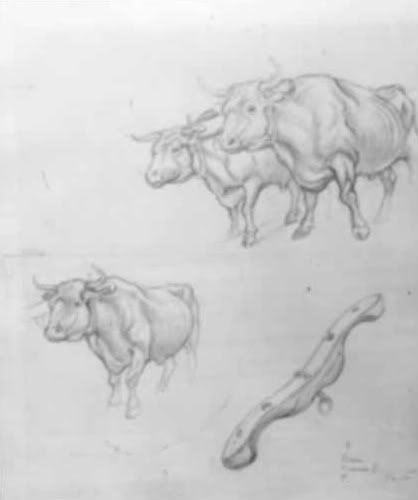So you’re a Mormon convert from one of the European cities or some American seaport. You’ve gathered as far as the frontier, and for the first time in your life you are faced with a team of oxen whose backs are about even with your head. You might welcome this advice from Asa G. Sheldon (1788-1870) of Massachusetts, whose 1862 autobiography Life of Asa G. Sheldon, Wilmington Farmer inspires you with confidence — he worked with oxen all his long life on enormous excavating and construction jobs: he even leveled Boston’s Pemberton Hill and carted away the earth by oxcart.
Selection and Management of Working Oxen.
A good ox should have a long, lean face, and bright hazel eye, which show capability to receive instruction and disposition to obey it. Large nostrils denote the capacity of an ox to work in a hot day. Very large horns at the base denote laziness. Full breast, straight back, wide ribs, – by which is meant ribs that round out nearly as wide as the hip bones, – and wide gambrels, denote strength. Straight knees, broad toes, pointing straight forward, show an ox can travel on hard roads or pavements. They should be well matched, especially in disposition and speed.
The farmer who has a pair of oxen, answering this description, has a good team.
The next thing is a good teamster. The better the ox, the easier he is spoiled by a man who knows not how to drive. The teamster should have judgment in loading. Some teamsters know no better than to think an ox can draw anything until he tries him. An ox should never be overloaded to begin with. He never should know how much he can draw, but always have such confidence in his driver, as to think he can draw anything he may ask him to.
A good teamster will have a name for every ox, and no two in the same team should be called by the same name; nor should he ever speak one word that has no meaning; but be sure when he calls an ox by name, to make him understand, and also to make him mind what he says.
When breaking a new team, the best way I ever found to make them know their names, is, when I call “Star,” or “Broad,” or “Bright,” or “Buck,” to just touch the one I speak to, with a spur. By that means the ox will soon know that he is meant, whenever he hears his name distinctly pronounced.
The driver should also have one particular word to start his team with. “Come boys,” I ever found the best word to start a heavy load with. Some seem to think, when they are driving a team, that they must work the whole time either with their tongue or whip. It would be a most desirable thing for such to learn, that when his team are doing just right, to keep both tongue and whip perfectly still. What would you think of an officer who when his men were marching as handsomely as possible, should keep swinging his sword and jabbering incessantly, without meaning?
All the words needed in driving, are very few. I think the following are sufficient: “Come,” “Haw,” “Gee,” “Whoa,” “Back.” These, properly used, are all that are needed. Much talk makes confusion.
I have known some men halloo and bawl all day long, and make themselves hoarse, who could not at night give any meaning to one word in ten they had said. Such would do well to first learn themselves, before they try to teach their oxen.
A good teamster will make his cattle love him. This can be done only by constant kind treatment; such as carding; stroking their faces, and occasionally breathing in their nostrils. This last, is the best method to find out the disposition of an ox. When you have breathed a few times in his nostrils, if he is kind he will hold up his nose, otherwise he will catch it away and perhaps toss a horn at you. In short, make yourself sociable with them and they will amply repay you for your attention and kindness. Never strike an ox, unless compelled by obstinacy; and by proper management that necessity will occur very, very seldom.
Asa G. Sheldon.
Wilmington, Mass., Jan. 27, 1868.
[Text from Samuel W. Cole, The New England Farmer (Boston: R.P. Eaton & Co., 1868), vol. 2, p. 236. Illustrations from mural (or pencil study for the mural) by Missouri artist Thomas Hart Benton (1889-1975) in the Missouri State House, completed 1936.]
Continue reading at the original source →



